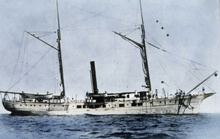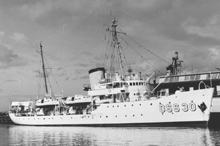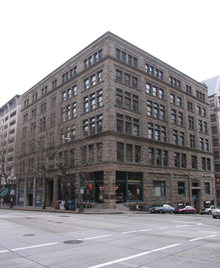NOAA's Fleet: A History of Keeping Research at Sea Afloat
Since the 1850s, NOAA and its predecessor agencies have operated a fleet of ships to gather information needed to create nautical charts, locate submerged obstructions and navigation hazards, collect data needed to manage our nation's fisheries, or increase understanding of the oceanographic and atmospheric conditions that impact our everyday lives. As of early 2007, the NOAA ship fleet consists of 19 active ships.
Whether it involves charting the waters along our coasts, exploring the canyons of the continental shelves and slopes, gathering information needed for military operations, helping us to understand and protect our fisheries, or observing the dynamics of our oceans and atmosphere, NOAA ships have been there.
NOAA has a rich maritime heritage that dates back to the 1800s. Over the years, NOAA ships have been instrumental in advancing our understanding of the seas and helping to protect our living resources. Today, NOAA's Marine Operations Center manages NOAA's fleet, including 19 active ships located on the East and West coasts of the U.S.
This article looks at a few of NOAA's most notable ships and at the evolution of the centers that have provided homes and services to NOAA's fleet over the years.
Some of NOAA's Notable Ships
Throughout history, NOAA ships and the vessels of its ancestor agencies, including the Commission of Fish and Fisheries and the Coast and Geodetic Survey (C&GS), have provided services ranging from mapping the seafloor to collecting oceanographic data and biological specimens. Some of these ships have left undeniable marks on our nation's history.
Bibb
The 160-foot Bibb was obtained by the Coast Survey in 1847, and was one of the Survey's most productive ships during its three decades of service.
As the Survey's first steamer, use of Bibb for charting quickly illustrated the advantages of steam over sail during hydrographic surveys. In this respect, Bibb was a revolutionary ship, forever releasing the hydrographic surveyor from the vagaries of wind and current.
For much of the Civil War, Bibb served honorably in the South Atlantic Blockading Squadron under the command of Coast Surveyor Charles O. Boutelle. The ship also served as a pioneering oceanographic research vessel off the Massachusetts and Florida coasts.
George S. Blake
George S. Blake, or just "Blake," was a 148-foot C&GS steamer built in 1874.
Blake was armed with the latest sounding and dredging technology, including a Sigsbee sounding machine and steel cables. Using this technology, the first truly modern bathymetric map of a deep sea area was made from Blake soundings conducted in the Gulf of Mexico. These soundings, as well as soundings made off the Atlantic seaboard and soundings made by Blake and Albatross in the Caribbean Sea, resulted in the first three-dimensional view of the seafloor.

The Coast and Geodetic Survey steamer Blake was in service from 1874 to 1905. Click image for larger view.
Under Lieutenant Commander John Elliott Pillsbury, of the U.S. Navy, deep ocean anchoring techniques were perfected aboard Blake. At one time, the ship was anchored in over 2,200 fathoms while conducting Gulf Stream observations. Pillsbury's Gulf Stream studies are considered among the best oceanographic observations made in the 19th century.
Blake was probably the most innovative oceanographic vessel of the 19th century, and the Gulf Stream studies conducted onboard the ship laid the groundwork for future charting and observations.
Albatross
In August 1882, the United States Commission of Fish and Fisheries launched the first vessel built especially for marine research by any government—the steamer Albatross. Perhaps even more impressive than being the first government vessel equipped throughout with electric lights, Albatross has been credited with discovering more new marine species than any other research vessel.

In 1882, work on the first research vessel ever constructed exclusively for fisheries research, Albatross, was started. Click image for larger view.
Albatross was specially designed with 4,500 fathoms of 3/8-inch galvanized wire rope and a winch for dredging and collecting bottom samples and animals at any depth. Electric lamps attracted fish and other animals to night light stations, allowing scientists to make underwater observations of marine organisms at night. Two onboard laboratories were used to preserve and study biological materials and chemically analyze water samples.
During its 40 years of service, Albatross surveyed the Newfoundland Banks and the Bering Sea, visited scattered archipelagoes of the Pacific, and served in two wars. Work conducted from Albatross ranged from investigating salmon and halibut, to conducting hydrographic work, to enforcing international regulations protecting fur seals on the Pribilof Islands.
The vast museum collections and library of scientific papers resulting from Albatross cruises substantiate the fame this vessel acquired in scientific circles around the world.
Pioneer III
The diesel-powered C&GS ship Pioneer III was acquired from the Navy in 1946 and served in the Pacific Ocean from 1946 to 1966 on various significant research studies.
In 1955, Pioneer III was equipped with a towed magnetometer, which is an instrument that measures the magnetic inclination of the seafloor. Using the magnetometer, Pioneer surveyed the coast of California on a cruise that became known as "The Pioneer Survey." Processing of the magnetic data collected during this survey helped lead to the discovery of magnetic striping on the seafloor. This discovery was instrumental in the development of the theory of plate tectonics.
Pioneer also took part in the International Indian Ocean Expedition in 1964, becoming the first C&GS vessel to conduct operations in the Indian Ocean.
Pathfinder
Although Pathfinder was the first C&GS ship to cost a million dollars, its true claim to fame came from its service during World War II.

The Coast and Geodetic Survey ship, Pathfinder, in port in Seattle, Washington. Click image for larger view.
Pathfinder was the first survey ship to have a nautical chart printing press installed onboard. During World War II, the vessel churned out thousands of charts for fleet units. Captain Junius Jarman of the C&GS was instrumental in developing techniques for chart printing in a shipboard environment.
Pathfinder was a lucky ship, having survived over 50 bombing raids even though it often worked well in advance of the rest of the Navy fleet. While anchored on what is now called Pathfinder Reef in the Marianas Islands, Pathfinder was closer to Japan than any other U.S. Navy vessel. The ship was also crashed by a Kamikaze at Okinawa.
As a testament to the important military service provided by Pathfinder, it has been said that "the road to Tokyo was paved with Pathfinder charts."
NOAA's Marine Operations Center
Throughout history, the ships of NOAA have called many places home. Today, NOAA's Marine Operations Center, or "MOC," is responsible for the management of NOAA's fleet. Although the MOC was formally established in 1999, its foundations—the Atlantic and Pacific Marine Centers—go back more than a century.
The Pacific Marine Center: The Nerve Center of the Western Fleet
The management of NOAA's Pacific fleet goes back to the mid-1850s, as the then Coast Survey began exploring the waters of Puget Sound to chart the previously unexplored waters of the Washington coast.

Constructed in 1898, the Bailey building was the first permanent office of the Coast and Geodetic Survey in Seattle, Washington. The building still stands today (renamed the Broderick Building) in Seattle’s Pioneer Square Historic District and is on the National Register of Historic Places. Click image for larger view.
The first permanent office for the Pacific fleet was established in Seattle by Captain John Francis Pratt. According to the October 17, 1898, issue of the Seattle Post-Intelligencer, Seattle was to "...become the headquarters for the coast and geodetic survey work of the Washington and Alaskan coasts." Over the years, this office would support several survey vessels, including Patterson, Gedny, McArthur, Surveyor, Discoverer, and Explorer.
By the early 1960s, Seattle was becoming a major center for nautical charting and oceanographic research. New quarters and piers were constructed for the C&GS on the east side of Lake Union. The new Seattle Ship Base was dedicated on July 10, 1963 and renamed the Pacific Marine Center. It remains the operational center for NOAA's West coast fleet.
The Pacific Marine Center is now called the Marine Operations Center-Pacific (MOC-P). MOC-P operates four ships homeported at its Seattle facility; three in Hawaii; and one each in San Diego, California; Kodiak, Alaska; and Ketchikan, Alaska. MOC-P is the key to NOAA meeting its responsibilities throughout the Pacific Ocean Basin.
Atlantic Marine Center: Born in Virginia
In 1933, an office was established in Norfolk, Virginia, to provide public relations and processing support for two ships in the area. By 1939, the office had expanded to 10 personnel, supporting a shore plotting office for six East coast ships and an airport compilation unit.
World War II had a definite effect on the Norfolk office because all efforts were directed to the war and the office expanded to include about 100 staff. In support of war efforts, staff compiled aeronautical charts, processed ship data, and secured dock space for ships.

An expanded emphasis on oceanography for the Coast and Geodetic Survey brought new ship construction and the need for more centralized operations of East coast ships and field parties. Hence, the Atlantic Marine Center, now called the Marine Operations Center-Atlantic, was built in Norfolk, Virginia, in the 1960s. Click image for larger view.
Completion of the bulkhead and dredging at the Norfolk base site on Smith Creek in 1961 marked the first time ship support was provided from a C&GS owned and controlled home base.
In 1964, the Norfolk office assumed the name Atlantic Marine Center (AMC). Photogrammetric offices at Tampa and Baltimore were closed and moved to Norfolk at the new center. In 1965, the C&GS, Weather Bureau, and the Central Radio Propagation Laboratory were combined under the newly formed Environmental Science Services Administration. With this reorganization came additional responsibilities, including management of all field operations for ships, field parties, airport mobile parties, and field offices located in Boston, New York, and New Orleans.
The AMC is now called the Marine Operations Center-Atlantic (MOC-A) and serves as the East coast center for NOAA's Atlantic and Gulf Coast fleet support. MOC-A directs the operations of eight research and survey vessels: two homeported at MOC-A in Norfolk; two in Pascagoula, Mississippi; two in Woods Hole, Massachusetts; and two in Charleston, South Carolina. NOAA's newest fisheries survey vessel, to be homeported in New England, will become operational in 2007.
Conclusion
The fleets of yesterday and today have been part of a continuing effort to chart our shores, understand and protect our fisheries, and explore the complex interactions between our oceans and atmosphere.
From the fleet's earliest beginnings, the capabilities of NOAA ships have increased significantly. Today, NOAA ships range from coastal vessels for research in estuaries and near-shore areas to deep-water oceanographic ships capable of providing scientists access to the global oceans. Most ships are equipped to conduct other types of research in conjunction with their primary missions.
NOAA ships are staffed by civilian crew and officers of the NOAA Corps, one of the nation's seven uniformed services. Providing NOAA with safe and reliable research platforms while operating in any ocean environment is the task of the MOC, the NOAA fleet, and its NOAA Corps officers and civilian crew—a service that has been consistently and reliably met.
Works Consulted
NOAA History. (2006). Tools of the Trade: Ships Web site. Retrieved August 18, 2006, from: http://www.history.noaa.gov/ships.html.
